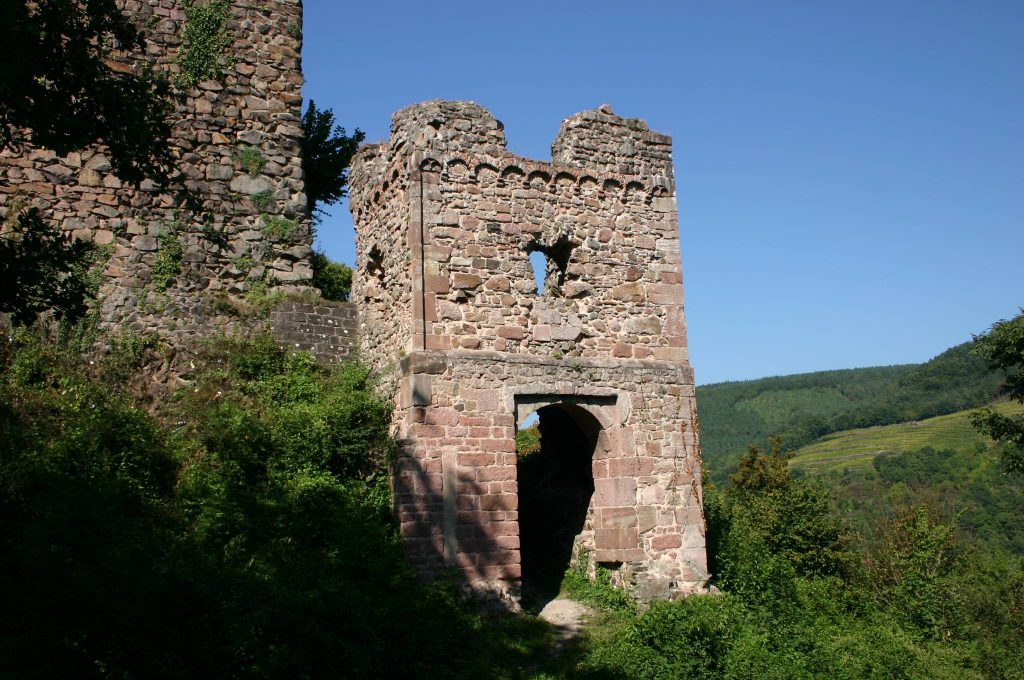Hugstein Castle
The most emblematic medieval building of the Florival is the castle of Hugstein. Located 389 meters above sea level, straddling the banks of Buhl and Guebwiller, this fortress was founded around 1227 by the 21e Abbot of Murbach, Hugo of Rothenburg. Its purpose was to protect the abbey of Murbach against enemy incursions, to serve as an occasional residence for the prince-abbots, but also to monitor the town of Guebwiller, which was still rebellious to its authority. It is in the form of a rectangle enclosing the main building, with the particularity of a slightly overflowing round keep, embedded in the surrounding wall which acts as a shield here. In 1313, a chapel dedicated to the Holy Cross and Saint Benedict was added there. In 1377-1387, part of the buildings were rebuilt after the passage of an English company of troops from Enguerrand de Coucy during the Hundred Years War. In 1457, the prince-abbot Barthélemy d'Andlau had the castle restored, modernized it and added two towers and a Renaissance door crowned with arcades. In ruins, it was then rebuilt one last time in 1514 by the prince-abbot Georg von Masmünster. The last castellan left the castle in 1546, which then served as a prison for witches or as a simple refuge. Its ruins served as a quarry during the French Revolution and the castle was finally classified as a historic monument in 1898.
Bucheneck Castle
On the northern edge of Soultz, property of the Bishop of Strasbourg since 1079, is another medieval symbol: the Château du Bucheneck. Cited as an episcopal possession from 1251, it was given as a fief to various nobles before being recovered by the bishop in 1289. The latter made it a fortress protecting the northern suburb and the residence of its bailiff (officer in charge of the administration of the district on his behalf). With its thick walls and powerful corner buttresses, the Bucheneck constitutes a solid bastion, between the outer wall and the inner wall: its deep moats can be fed by a diversion from the canal des moulins and be emptied into the Rimbach. Damaged during the Thirty Years War, during the sack of Soultz by the Count Palatine of the Rhine in 1634, it was restored at the beginning of the XNUMXth century.e century. Bishop Armand-Gaston de Rohan-Soubise wanted it destroyed in 1719, but the inhabitants of Soultz opposed it. The castle was sold as national property during the Revolution and successively became the property of the Delévièleuse, Kussmaul and Latscha families. Used as a factory in the XNUMXthe century, interior transformations suppressed all previous arrangements. Still occupied by a factory at the beginning of the XXe century, the Bucheneck became a dwelling in 1969 and was bought by the City in 1976. Restored, it has housed the municipal museum of Soultz since 1990.
The fortified cemetery of Hartmannswiller
If the remains of medieval architecture are mostly places of worship and castles, they are not the only ones. Thus one can find in Hartmannswiller the best preserved fortified cemetery in Alsace, with that of Hunawihr. Its precise date of construction is not known, but it is thought to be more or less contemporary with the modifications made to the church it surrounds, around 1495, i.e. in the last decade of the Middle Ages. The church and cemetery (still in use) are on the eastern edge of the village, on flat ground. They are surrounded by a roughcast rubble wall, 2,7 meters high and 80 to 90 centimeters thick. 2,2 meters above the ground, a row of crows (all broken) carried a walkway. A round corner tower is preserved on two levels. The gate (with drawbridge but without portcullis) was in a cutaway at the north corner. The gap, largely filled in, was still full of water, to the north, a century ago.

